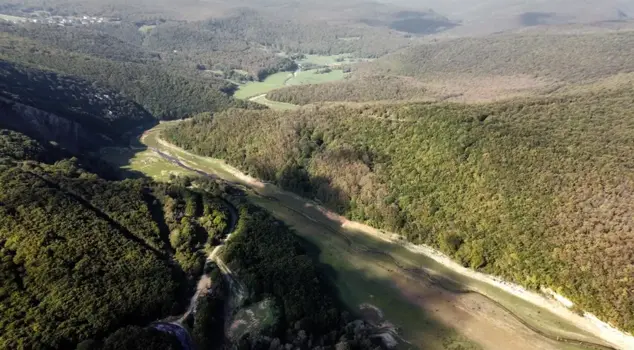
07.11.2024 13:14
The water levels in the 10 dams supplying Istanbul have dropped to 30.18% following a dry and rainless summer. The water levels in the Alibeyköy, Kazandere, and Papuçdere dams have fallen below 10%. Prof. Dr. Lokman Hakan Tecer from Tekirdağ Namık Kemal University stated, "When we calculate the daily consumption, it means we have 85 days' worth of water left, which is truly alarming."
According to İSKİ data, the water level in the 10 dams supplying Istanbul's water needs has dropped to 30.18%. The water levels in the Kazandere, Pabuçdere, and Istrancalar dams located in the Vize district of Kırklareli, which supplies water to Istanbul from Alibeyköy and Thrace, have reached their lowest levels in recent years.
The water levels in the Alibeyköy, Kazandere, and Papuçdere dams have fallen below 10%. With a low of 8.56%, Kazandere's dried sections are now grazing grounds for animals. The only dam with a water level above 50% is the Elmalı Dam, which has a measured water level of 51.93%.
ALİBEYKÖY DAM AT ITS LOWEST LEVEL IN 10 YEARS
The water level in the Alibeyköy Dam, which was measured at 76.6% in January 2024, has now dropped to 6.07%. While a large portion of the dam lake has dried up, it has been observed that livestock are grazing in areas that were previously filled with water. The historical aqueducts have also emerged as the water recedes. The measured water level in the Alibeyköy Dam has been recorded as the lowest level in the last 10 years.
THE LEAST RAINFALL IN 10 YEARS
According to İSKİ data, the amount of rainfall received by the dams this year has fallen significantly behind previous years. In 2023, the dams in Istanbul received 852 kilograms of rainfall per square meter, while this year, only 480 kilograms of rainfall fell per square meter. This figure is noted as the lowest rainfall amount in the last 10 years. In 2021, the dams in Istanbul received 901.3 kilograms of rainfall per square meter.
HIGHEST WATER LEVEL IN ELMALI, LOWEST IN ALİBEYKÖY
The highest water level in Istanbul's dams is measured at 51.93% in the Elmalı Dam, while the lowest water level is recorded at 6.07% in the Alibeyköy Dam. The current water levels in Istanbul's dams are as follows:
Ömerli 26.83%, Darlık 32.24%, Elmalı 51.93%, Terkos 40.67%, Alibeyköy 6.07%, Büyükçekmece 32.46%, Sazlıdere 41.93%, Istrancalar 34.14%, Kazandere 8.27%, Papuçdere 7.95%
"ALARMING"
Prof. Dr. Lokman Hakan Tecer, Dean of the Faculty of Engineering at Tekirdağ Namık Kemal University, stated that there has been a significant drop in the dams supplying Istanbul due to the drought caused by extremely hot and rainless summer months. Tecer said, "The water levels in the dams supplying Istanbul have dropped to around 30%. This means that when we calculate the daily water consumption for domestic, urban, and industrial use in Istanbul, there is approximately 3 million cubic meters, or tons, of water consumption. With the current water level in the dams, we have 264 million cubic meters of water available. When we calculate daily consumption, this means we have 85 days of water left, which is truly alarming. This is a reality; the decrease in average rainfall due to climate change and the increase in temperatures leading to higher evaporation are reducing the water levels in these dams. This is a fact of our lives. We may be able to combat climate change, but more importantly, we need to review the areas and sectors where we consume water. Where are we using it? We consume water for our domestic needs, in urban businesses, and for industrial activities. Therefore, considering this reality, we need to start questioning our water-based lifestyle and use water more conservatively," he said.
"WE NEED TO HARVEST RAIN"
Tecer, who stated that the water levels in the dams are dependent on rainfall, said, "Since this is also affected by climate change, what we can do here is to combat climate change and transition to a lifestyle that includes adaptation, but more importantly, we need to take precautions while consuming water. Personally, we need to use the water we consume in a conservative manner. We need to reduce domestic and industrial water consumption. There should be a shift to less water-intensive sectors, especially in this region. We also need to ensure the recovery of water. In other words, we need to harvest rain. In agricultural irrigation, we need to abandon flood irrigation and switch to drip and sprinkler irrigation. Municipalities should use treated and recycled water, known as greywater, instead of tap water for park and garden irrigation. However, we have not been able to make these practices a way of life. We are neither aware of the depletion of our water resources individually, nor have we yet adopted a mindset to implement these precautions at the institutional level. This is fundamentally our shortcoming. A mindset transformation is needed. We need to realize with all our being and thought processes that we are a country with limited water resources, experiencing water stress," he concluded.